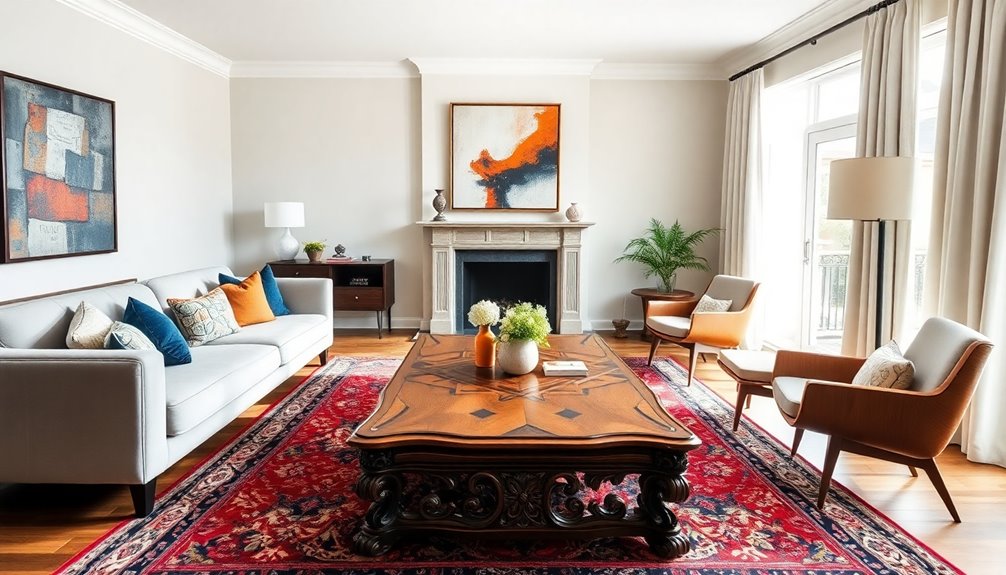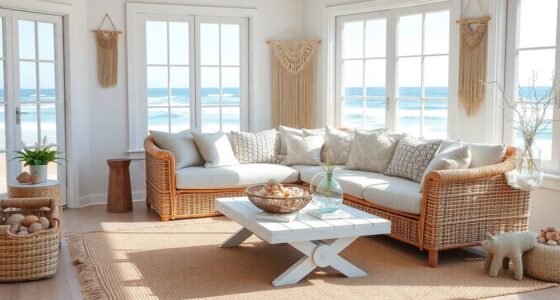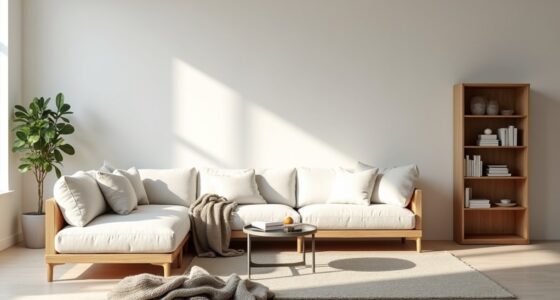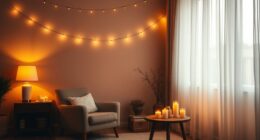Mixing modern furniture with traditional decor can transform your space into a stylish conversation starter. Start by choosing a dominant style to anchor the room, then incorporate modern accessories for balance. Aim for a cohesive color palette that blends neutral tones with warmer hues. Pair large traditional pieces with sleek modern items to enhance visual interest. Don't shy away from mixing materials like rich wood with glass, and consider layering textures for depth. Personal touches, like vintage finds or family heirlooms, add character. With these expert tips, you can create a harmonious design that feels uniquely yours. There's more to discover!
Key Takeaways
- Establish a dominant style to anchor the room, allowing for thoughtful integration of modern and traditional elements for visual harmony.
- Achieve proportional balance by pairing bold traditional pieces with sleek modern accessories to create a cohesive aesthetic.
- Use a unifying color palette, combining neutrals with warm hues to connect diverse furniture styles seamlessly.
- Mix materials and textures, such as rich wood with glass, to add depth and interest to the overall design.
- Introduce contemporary art or accessories to enhance contrast and visual depth, creating a dynamic decor narrative.
Understanding Furniture Styles
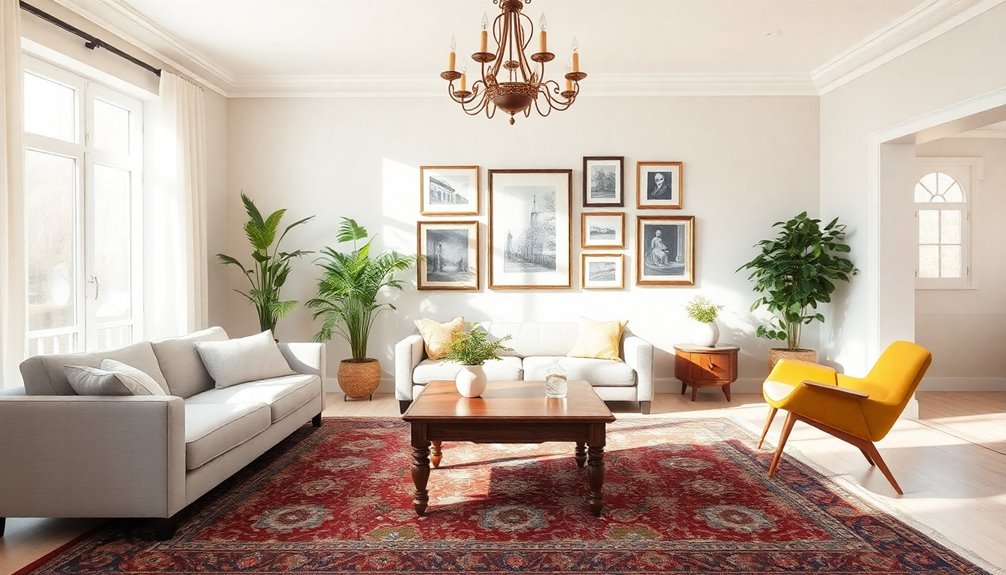
When you start exploring furniture styles, it's important to recognize the distinct characteristics that define modern and traditional designs.
Modern furniture, emerging post-1940s, emphasizes minimalism and functionality, showcasing clean lines and a palette of neutral and bold shades.
In contrast, traditional furniture often features ornate details and rich wood materials, reflecting historical styles like Chippendale and Victorian. The calm, orderly aesthetic of traditional style creates a warm ambiance.
While contemporary furniture is created without a defined historical context, blending traditional and modern styles can produce a unique design narrative.
Principles for Mixing Styles
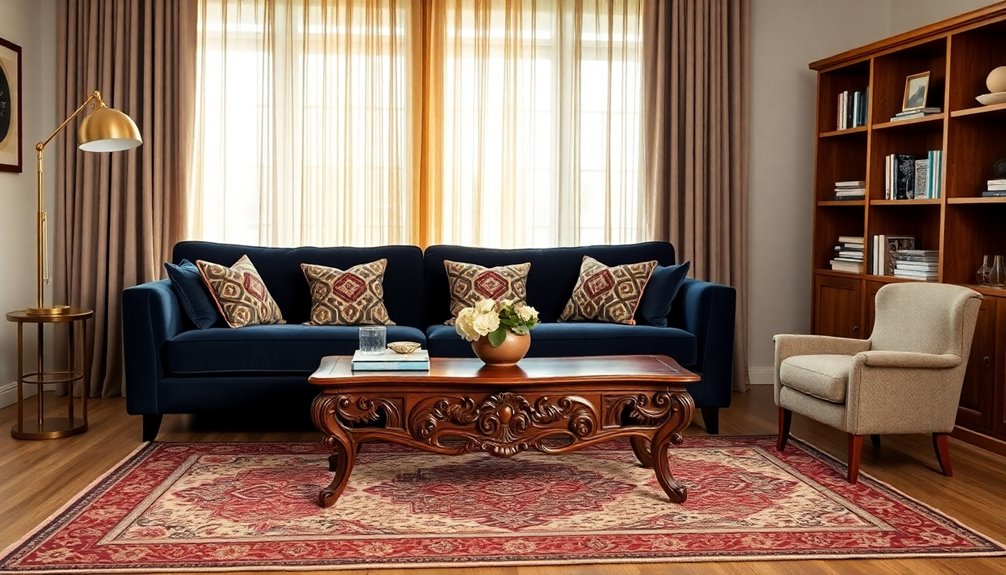
Mixing modern and traditional styles requires a clear strategy to guarantee harmony in your space.
Start by establishing a dominant style that anchors the room, ensuring that your modern accents and traditional furnishings work together cohesively.
Thoughtfully blend materials, incorporating a few items from the secondary style to maintain visual balance without overwhelming the space.
Pair large traditional furniture with sleek modern accessories to achieve proportional balance, allowing each piece to complement the other.
Use a cohesive color palette to unify diverse styles, picking common colors to enhance harmony.
Finally, introduce contemporary art or accessories to bring freshness into traditional settings, creating a dynamic contrast that effectively highlights both styles. Additionally, consider incorporating sustainable materials throughout the design, as they can enhance the aesthetic while promoting eco-friendliness.
Architectural Influence on Design

As you consider blending modern furniture with traditional decor, the architecture of your space plays an essential role in shaping your design choices. Strong architectural influences, like arched doorways or crown molding, provide a solid backdrop that enhances modern pieces.
In a modern home with high ceilings and large windows, you can comfortably mix large traditional furniture with sleek designs without overcrowding.
However, in spaces with rustic or industrial architecture, modern elements can clash, so it's important to select decor that complements the existing features.
Ultimately, let the room's structure guide your predominant style choice, ensuring a harmonious blend that reflects both modern and traditional influences in your design.
Shopping for Unique Pieces
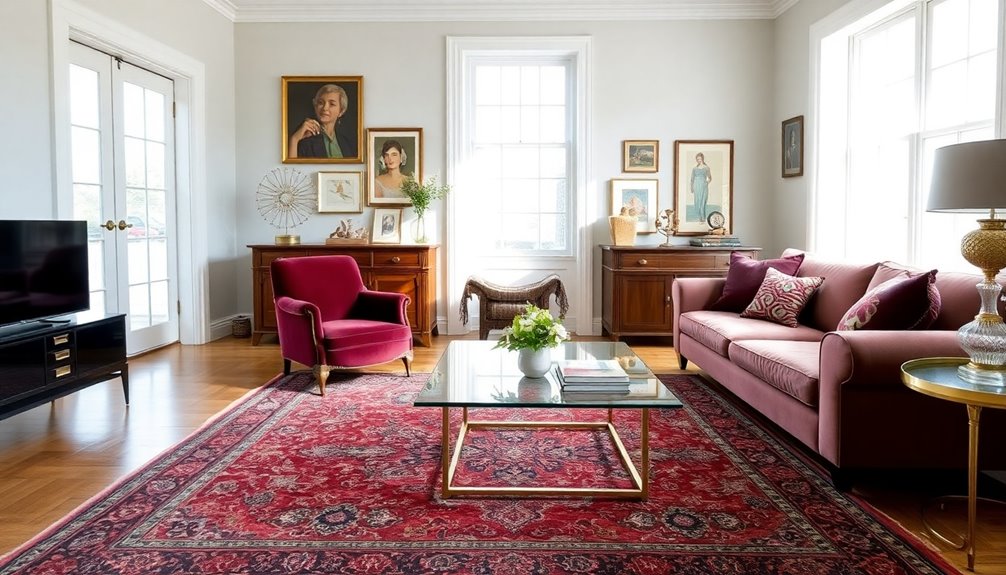
How can you find unique pieces that seamlessly blend modern furniture with traditional decor? Start by exploring curated collections at retailers like Anthropologie and West Elm, where you can mix and match styles effortlessly. Online platforms such as Facebook Marketplace and Vinterior offer local vintage finds that introduce character into your space. Don't forget to visit flea markets for diverse suppliers that showcase unique vintage items. Junk shops and charity shops in affluent areas often hide treasures that enhance your decor without spending much. Finally, engage with community platforms like Freegle for free items, adding a unique touch while supporting sustainability. Incorporating natural materials into your decor can also enhance the farmhouse aesthetic, bridging the gap between modern and traditional styles.
| Source | Type of Items | Benefits |
|---|---|---|
| Anthropologie/West Elm | Curated collections | Cohesive modern-traditional blend |
| Facebook Marketplace | Vintage finds | Local character |
| Flea Markets | Diverse suppliers | One-stop shop for variety |
| Junk/Charity Shops | Hidden treasures | Budget-friendly options |
| Freegle | Free items | Sustainable and unique touches |
Creating a Harmonious Layout

Creating a harmonious layout is essential for blending modern furniture with traditional decor, ensuring your space feels cohesive and inviting.
Start by arranging furniture to promote flow, keeping pathways clear for easy movement. Use area rugs to define distinct areas, unifying both styles and establishing a cohesive design narrative.
Group similar styles together to avoid visual chaos; position traditional pieces near modern accents to create a seamless blend. Maintain symmetry in your arrangements for a polished look that enhances harmony.
Finally, incorporate strategic lighting to highlight key pieces from both styles, creating visual interest and enhancing the room's ambiance.
These tips for mixing traditional and modern furniture will help you achieve a balanced, inviting space.
Color and Material Considerations

When mixing modern furniture with traditional decor, focus on creating a cohesive color palette that combines neutral tones with warm hues. You can also enhance your space by contrasting materials; think sleek glass alongside rich wood. Finally, balancing textures will add depth and interest, making your design feel both inviting and stylish. Incorporating natural elements like woven baskets and fresh flowers can further enhance the visual appeal of your space.
Color Palette Cohesion
To achieve a harmonious blend of modern furniture and traditional decor, it is essential to focus on a cohesive color palette that unifies the space. You can limit your color palettes to combinations like black, white, and greenery, which effectively enhance the overall aesthetic. By incorporating a few key colors that resonate across both styles, you create a unified look that simplifies accessory selection.
Here's a quick guide to help you choose your colors:
| Color | Modern Furniture Example | Traditional Decor Example |
|---|---|---|
| Black | Leather Sofa | Vintage Table |
| White | Minimalist Shelving | Classic Armchair |
| Greenery | Potted Plants | Floral Curtains |
| Neutral Tones | Area Rug | Antique Frames |
Experimenting with these combinations can introduce depth while maintaining balance. Additionally, incorporating natural elements into your decor can further enhance the tranquility of the space.
Material Contrast Techniques
While blending modern furniture with traditional decor, you'll find that contrasting materials can elevate your space's visual appeal.
Try mixing sleek metal and glass from modern furniture with the warm, textured woods typical of traditional decor. This dynamic contrast enhances visual interest.
Stick to a limited color palette, pairing neutral tones from modern pieces with rich, warm hues from traditional items to unify the overall aesthetic.
Utilizing contrasting finishes, like shiny ceramics alongside matte, rustic textiles, adds depth and highlights each style's unique qualities.
Layer different materials, such as a modern leather sofa on a vintage oriental rug, to create an engaging interplay.
Finally, use repetition of materials, like matching a modern metal lamp with traditional metal accents, for continuity across your mixed-style room. Additionally, incorporating functional cookies in your online shopping experience can help you find the perfect decor pieces tailored to your tastes.
Texture Balance Strategies
Mixing modern furniture with traditional decor requires careful attention to texture balance for a harmonious look.
To achieve this, juxtapose shiny surfaces like glass or metal with warm, rustic textures such as wood or fabric. This enhances visual depth in your space. Incorporate a diverse color palette that includes both neutral tones and bold accents to unify contrasting styles.
Layer different textures, like pairing a sleek modern sofa with a vintage patterned area rug, to create a dynamic aesthetic. Use textiles that blend materials from both styles, such as modern linen with traditional embroidery, to bridge the gap.
Finally, balance large, ornate traditional pieces with streamlined modern accessories to maintain visual equilibrium in the room.
Personalization and Unexpected Elements
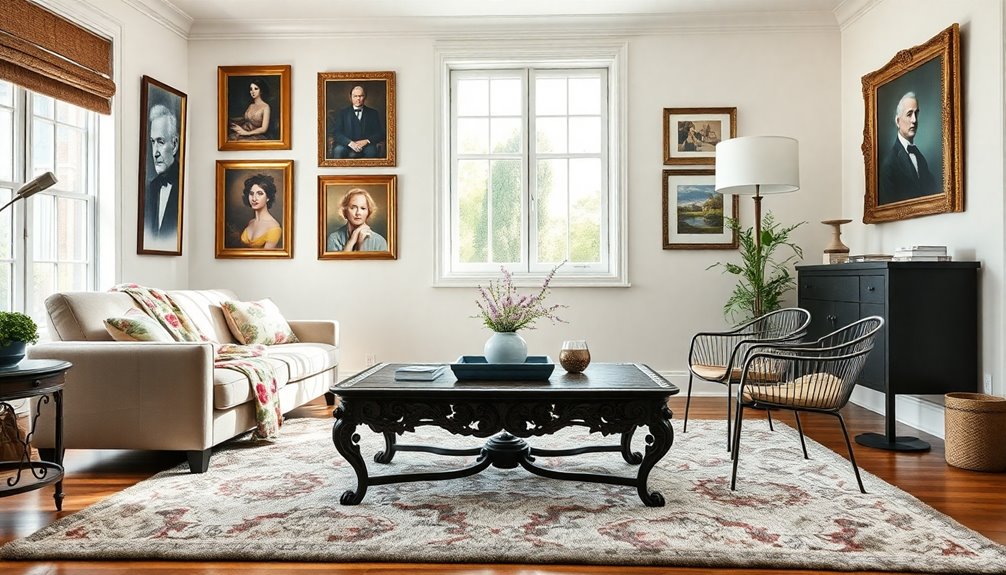
To truly make your space feel like home, consider incorporating unique statement pieces that surprise and delight. Mixing unexpected materials can create a dynamic contrast, while personal touch accessories add your individual flair. This approach not only enhances the visual appeal but also tells a story that reflects your style. Additionally, incorporating attention to detail in your decor will distinguish your space and elevate its overall aesthetic.
Unique Statement Pieces
Incorporating unique statement pieces into your decor not only elevates your space but also reflects your personal style. Consider adding a vintage chandelier or a contemporary sculpture to serve as focal points that bridge modern furniture with traditional decor.
These items add depth and personality, transforming any room. A bold, abstract painting can create fresh contrast against classic furnishings, enhancing visual interest.
Personalizing your space with eclectic items, like a mid-century modern chair paired with an antique side table, harmonizes styles while showcasing your taste.
Additionally, handcrafted artisan vases or Baroque mirrors not only enrich the ambiance but also spark conversations.
Embrace these unique statement pieces to create a dynamic and inviting atmosphere in your home.
Unexpected Material Combinations
Pairing modern furniture with traditional decor opens the door to exciting opportunities for unexpected material combinations.
Think about a sleek modern glass table contrasting with a vintage wooden dining set; it creates a striking visual depth. You can also introduce a contemporary metal lamp alongside an ornate traditional mirror to highlight the unique qualities of both styles.
Layering textures enhances the tactile experience—like a plush modern sofa on a rustic wool rug.
Using unexpected decorative items, such as a classic Baroque chandelier in a minimalist contemporary space, invites conversation and bridges different styles.
Mixing materials like distressed leather with polished chrome not only emphasizes each element's beauty but also maintains a cohesive aesthetic throughout your home. Additionally, integrating vintage accessories can add a rustic touch that complements the modern elements beautifully.
Personal Touch Accessories
While blending modern furniture with traditional decor, adding personal touch accessories can transform your space into a reflection of your unique style.
To harmonize personal style with traditional elements, consider incorporating unique accessories that tell your story. Unexpected pieces can create visual intrigue and add character to your space.
Here are some suggestions:
- A vintage Baroque mirror for a touch of elegance
- Handcrafted pottery that showcases artisanal skills
- An oversized contemporary art print as a bold focal point
- Family heirlooms or travel souvenirs that evoke memories
Mixing these elements not only bridges modern and traditional styles but also infuses warmth and individuality into your decor. Additionally, consider using mood boards to visualize how these accessories will interact within your space.
Embrace the unexpected, and let your personality shine through!
Maintenance and Adaptation Strategies
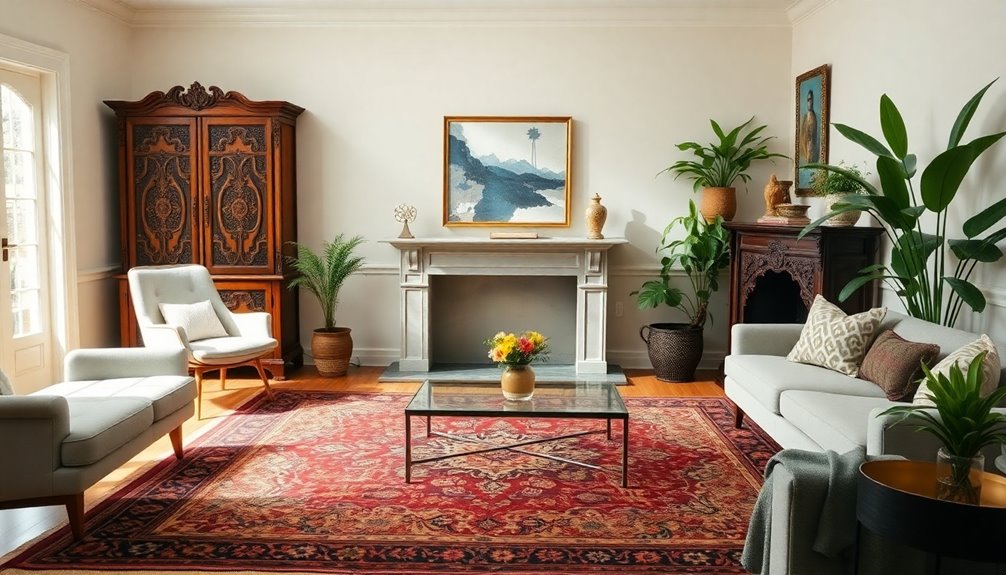
To maintain a harmonious blend of modern and traditional decor, regularly assess how well your pieces complement each other. This guarantees a cohesive aesthetic throughout your space.
Don't hesitate to adapt your approach by updating accessories seasonally, reflecting changing trends and your evolving tastes.
For traditional furniture, prioritize maintenance by repairing and refinishing items to preserve their integrity while meeting contemporary needs.
Documenting changes over time helps you track your style evolution, making it easier to blend different furniture styles in the future.
Finally, select decor that bridges both modern and traditional designs, focusing on impactful accessories that enhance the overall aesthetic without overcrowding your space. This balance keeps your decor fresh and relevant. Additionally, consider how cultural understanding can play a role in incorporating elements from diverse styles, enriching your decor experience.
Frequently Asked Questions
Can You Mix Traditional and Modern Furniture Together?
Yes, you can definitely mix traditional and modern furniture together!
Start by choosing a dominant style to anchor your space. You might pair an ornate antique table with sleek, modern chairs to create balance.
Stick to a limited color palette to unify the look, and consider adding contemporary art or accessories for a fresh twist.
This combination can reflect your personal style while ensuring that the pieces complement rather than compete with each other.
What Is the 2/3 Rule for Furniture?
The 2/3 rule for furniture suggests that you should dedicate about two-thirds of your room's design to furniture and decor, leaving one-third open for flow.
This approach helps maintain balance, preventing your space from feeling cluttered. To apply it, measure your room's total square footage and allocate that two-thirds for your furniture.
Keep the size and scale in mind to guarantee everything harmonizes, creating a welcoming and organized environment.
How to Make Traditional Furniture Look More Contemporary?
To make traditional furniture look more contemporary, you can reupholster with bold fabrics, swap heavy drapery for sheer treatments, and incorporate sleek accessories.
You'll want to use a monochromatic palette with pops of color and introduce modern art pieces to create contrast.
What Is the 70/30 Rule in Interior Design?
The 70/30 rule in interior design helps you create a balanced space.
You'll want to dedicate 70% of your decor to one dominant style, ensuring it sets the overall tone. The remaining 30% can introduce contrasting elements, adding interest without overwhelming the room.
This approach maintains visual cohesion while allowing your personal taste to shine through. By following this rule, you'll prevent a cluttered look and achieve a harmonious design.
Conclusion
Mixing modern furniture with traditional decor doesn't have to feel like a juggling act. By embracing the beauty of contrast and allowing each piece to shine, you can craft a space that's both inviting and intriguing. Remember, it's all about balance and the delightful surprises that come from unexpected pairings. So, let your creativity flow and watch as your home transforms into a harmonious blend of styles, making it truly yours without skipping a beat.
